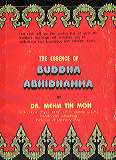
NIBBANA
Dr. Mehm Tin Mon, Ph. D.,
(Saddhamma Jotikadhaja)
(Professor in Samatha Patipatti)

|
|
NIBBANADr. Mehm Tin Mon, Ph. D., (Saddhamma Jotikadhaja) (Professor in Samatha Patipatti) |
 |
| ( Extracts from the 'Essence of Buddha Abhidhamma', 1995) | ||||||||||||||||||
1. Nibbana is supramundane (lokuttara), that is, beyond the 31 planes of existence, beyond the world of mind and body (i.e. the five aggregates). 2. Nibbana is realized through the knowledge belonging to the Four Paths and the Four Fruits. It is observed by magga-nana and phala-nana. 3. Nibbana is the object of the four Paths and their Fruits. In Sanskrit, Nibbana is called Nirvana which is composed of 'ni' and ' vana'. ' Ni' implies ' to be free from' , and ' vana' means 'weaving or craving'. It is this craving (tanha) which acts as a cord to connect the series of lives of an individual in the course of his wanderings in Samsara - the external cycle of birth and death. As long as one is entangled by craving, one accumulates fresh kammas which will give rise to new birth and death repeatedly. When all forms of craving are annihilated by the four Paths, kammic force ceases to operate and one escapes from the cycle of birth and death. Then one is said to attain Nibbana. The Buddhist concept of ' Deliverance or Liberation' is this escape from the ever-recurring cycle of birth and death and all the misery associated with them. By nature or intrinsically Nibbana is peaceful (santi). As such it is unique. Though it is single by santi-Iakkhana, Nibbana is viewed as twofold according to the way it is experienced before and after the death of an arahat. (1) Sa-upadisesa-Nibbana Sa=with, upadi =the five aggregates grasped by craving and false view; sesa ;=remaining. In Buddhas and arahats, though all defilements (kilesas) have been annihilated, vipaka-cittas and their concomitants (together known as vipaka-namakkhandha) and kammajarupas still remain. Yet Buddhas and arahats can experience Nibbana fully. The element of Nibbana which is realized by Buddhas and arahats before death with vipaka-namakkhandha and kammajarupas remaining is called sa-upadisesa Nibbana-dhatu. (2) Anupadisesa-Nibbana This is the Nibbana experienced by 'Buddhas and arahats after death. The element of Nibbana which is realized without any vipaka-namakkhandha and kammaja - rupa remaining is called anupadisesa Nibbana-dhatu. Sa-upadisesa Nibbana=Kilesa Nibbana, i.e. it is attained by the annihilation of kiIesas. Anupadisesa Nibbana=Khandha Nibbana i.e. it is attained by the annihilation of the five aggregates. Three Modes of Nibbana 1. Sunnata-Nibbana Nibbana is devoid of lust, hatred and ignorance; it is also devoid of groups of rupa and nama. So it is called Sunnata-Nibbana. Sunna =void or zero; here it means that lust, hatred, ignorance, rupa and nama are zero, but it doesnot mean that Nibbana is 'nothingness'. 2. Animitta-Nibbana Material groups, which are composed of rupa- kalapas, have different forms and shapes. Mental groups consisting of citta and its concomitants may be assumed to have some kind of form for they can be seen by certain persons who have developed super-normal power (abhinnas). Nibbana, however, has no form and shape at all. Thus it is called Animitta-Nibbana. 3. Appanihita-Nibbana Nibbana has no nama and rupa nor any form and shape to be longed for by tanha (craving or lust). Neither is there any lust or craving in Nibbana. Nibbana is absolutely free from lust as well as from the hankerings of lust. So it is known as Appanihita-Nibbana. Some more Definitions of Nibbana
|
||||||||||||||||||
This page at Nibbana.com was last modified: